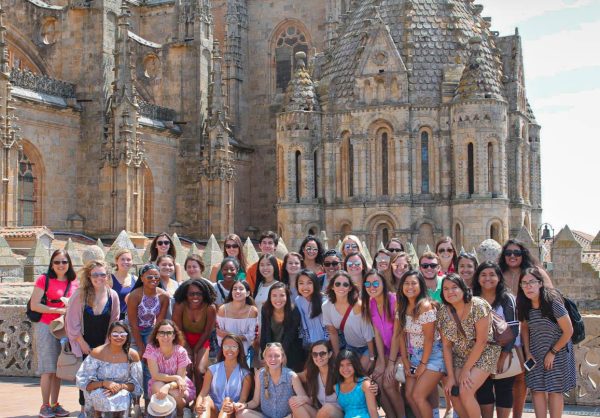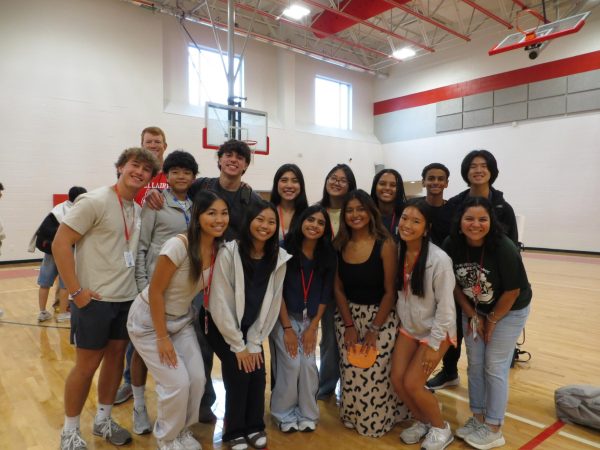New Moon: ‘A new growth or a new start’
Students and teachers share traditions and meaning behind Lunar New Year
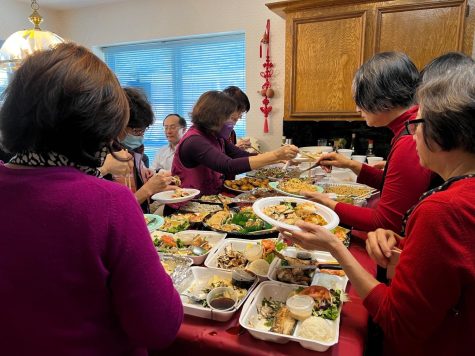
Luck is hard to come by and for her father, so was laughter.
But with every Lunar New Year, both of those arrived in abundance for Chinese teacher Chu Tsai.
“Whenever [my father] was with us, his daughters, he had almost no voice,” Tsai said. “You could barely hear him when he spoke. But, when he sees his brother on new year, he’d be overjoyed. I’ve always loved the Lunar New Year because [my father] would be able to talk to and share stories with my uncle whom he hasn’t seen for a long time.”
On top of the family reunions on Lunar New Year, Tsai also likes to use the holiday as an opportunity to help her students learn more about the underlying culture.
“I think students can learn more about Chinese culture and know more about the Chinese people,” Tsai said. “They can fall in love with the special holidays because they think it’s very interesting and different from other cultures.”
Celebrated in most of East and Southeast Asia, Lunar New Year, falling on Jan. 22 this year, goes by a myriad of different names: Chun Jie (China), Tet Nguyen Dan (Vietnam), Seollal (South Korea) and Songkran (Thailand).
But no matter what it’s called, Lunar New Year is full of rich traditions. For Tsai, those traditions had their most memorable moments in Taiwan when she celebrated the holiday there as a child.
“We had to clean the house,” Tsai said. “We’d cut our hair and nails and do our laundry before new year’s. We would not use sharp things like knives because that would give us bad luck. Then, during Lunar New Year, we would go to neighbors and relatives to get red envelopes and the more envelopes we got, the more blessings we would receive. Also, as a student, we had to clean our classrooms. My mother would always say if you cleaned and organized your desk well, then the gods would give you more knowledge.”
English teacher Jennifer Ho, who also celebrated Lunar New Year abroad during her childhood, said the holiday in her hometown, in comparison to in the states, differed the most in how widely it was observed.

“In Hong Kong, it’s more celebrated by everyone around us,” Jennifer said. “There were lights all along the building, decorations everywhere. There were festivals all around and people would travel a lot from mainland to Hong Kong or Hong Kong to mainland depending on where their families were and where they would travel from.”
For Ho, she’d travel to the New Territories to celebrate the new year with one of her uncles.
“We used to go there for dinner and my aunt would always make the dishes that are meant to be made for that night to give you good luck,” Ho said. “We would, in Cantonese ‘bai nian’, pray and we would also light up incense, wish them happy new year and burn money to help them wherever they are.”
Since Ho and her family lived in Hong Kong, they’d also celebrate Christmas and New Year’s (Jan. 1) a month or so before Lunar New Year would arrive. Ho said celebrating the western holidays beforehand gave Chinese New Year all the more cultural significance.
“We got days off, but it’s not like Independence Day or another national holiday,” Ho said. “It’s a cultural holiday. It’s not a spiritual or religious holiday, like Christmas or Easter or anything like that. It’s a cultural thing and everyone’s excited. It just reminds you back to what your roots were.”
Biology teacher Caroline Vu, who celebrates Tet, Vietnam’s Lunar New Year, shares the same feeling. Vu said the holiday reconnects her back to the Vietnamese part of her identity.
“It gives me a sense of ‘Oh, I’m Vietnamese’ because these are traditions that we’re trying to instill in the next generation,” Vu said. “I think it has one common meaning where you’re celebrating the new year and you’re hoping prosperity will come to you, like good health, good wealth.”
Like Vu, AP coordinator Lam Ngo appreciates Tet’s cultural importance, but said he also stresses the significance of celebrating with family during Tet.
“It’s [Tet] just something I’ve done since I was a kid and it’s ingrained in my life,” Ngo said. “It’s nice to see all my cousins when they come from all different cities back home. And that’s another thing, we always play cards. We gamble and play Tien Len, which is like a card game. Americans call it VC, or Vietnamese Card game.”
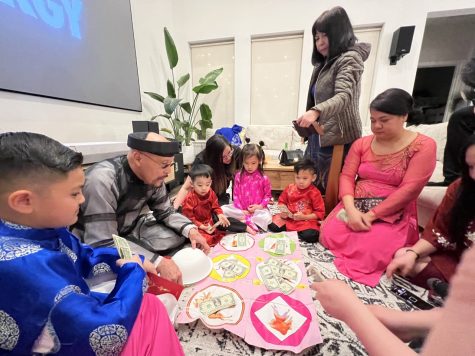
Along with VC, one particular tradition, red envelopes, back when he visited Vietnam in 2008 to celebrate Tet, sticks out the most to Ngo.
“I hadn’t celebrated New Years in Vietnam since I was a kid so my aunt gave me money for the same amount I’d been gone,” Ngo said. “She gave it to her kids every year. So she calculated all the money she would’ve given me ever since birth, so however old I was back in 2008, she gave me all the money from all the years that I missed. It was quite a bit but I left most of it back home and gave it to my cousins.”
Though Lunar New Year celebrations between Asia and the states differ in scale, the traditions remain the same according to junior Jingyu Wu, who lived in China until moving to the U.S. in 2017.
“In the new year, my parents and relatives gave me red envelopes that had the lucky money in it and wished for me to have a great year and get a lot of money in it,” Wu said. “And, we would also eat dumplings which look like a money bag called yuan bao, and wish for money next year. We also have a family union dinner and would paste the red couplets on a door to wish for a great year.”
But, two years ago, the pandemic interrupted these festivities and family gatherings for many, but fortunately for Ho, she and her family found themselves together during those times.
“That was hard because we weren’t able to meet up with everyone,” Ho said. “But, at least this time during the pandemic, my parents and I all lived together because we lived on a farm for almost two years. So we were able to be there together as a whole family, but then we couldn’t see our aunts, uncles and cousins and we also lost some aunts and uncles to Covid-19 and that was really tough. But it was still good to be around family.”
Though Chun Jie and Tet both stress the importance of family, junior Samantha Ho, who has Chinese and Vietnamese roots, said the two cultures do have their differences in tradition.
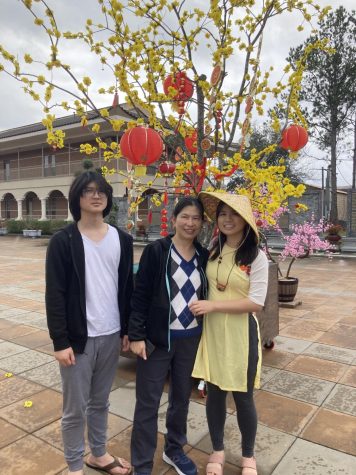
“I always go out to eat with my family for Lunar New Year,” Samantha said. “I have the Chinese side and the Vietnamese side of my family, so we eat different things. There’s dim sum and then there’s also, just for Vietnamese people, we eat this sticky rice roll filled with mung beans and then pork wrapped in bamboo leaves. For Tet, we’re supposed to have these lanterns that you make. And for Chinese New Year, we mainly just watch the lion dances, but for both cultures, we do red envelopes.”
Samantha also went to Vietnamese temples to pray for the coming new year. Like Samantha, her fellow classmate and senior James Kong also visited the temples.
“It really takes you away from the hustle and bustle of school and stuff,” Kong said. “Like Samantha and her family, we also visited the temple for New Years. And then my mom told us how this is very similar to how it is in China with all the people dressed up and celebrating at the temple. I really saw how different it was from traditional American culture.”
Because of all these traditions, Samantha said she’s grown more connected with both her Vietnamese. More importantly, she’s also learned that Lunar New Year is not just Chinese New Year.
“Generally, I’ve always called it Chinese New Year, but I know now it’s supposed to be called Lunar New Year,” Samantha said. “Even though a lot of Asian cultures were influenced by Chinese culture, they really have different traditions. They eat different foods. They do different things, so it’s more diverse than just Chinese culture.”
Ngo also acknowledges that most people associate Lunar New Year mostly with Chinese New Year. In fact, he admits that he only recently learned about the difference in zodiac signs between Tet and Chun Jie.
“Apparently we have two different years,” Ngo said. “In Chinese culture, it’s the year of the rabbit. But in Vietnam, they’re celebrating the year of the cat.”
For others like Ho, cultural awareness of Lunar New Year depends on a person’s community. One incident with one of Ho’s close friends on Chinese New Year underlined the lack of awareness surrounding the holiday.
“She called me because she had sent something: a picture of her Chinese New Year party,” Ho said. “And so everybody is like: ‘Happy Chinese New Year’, but one person said: ‘New Year’s over, stop texting me. I don’t care’ which was very hurtful. In my mind, that’s ignorant. And she was really upset so she asked me to text him for her and he ended up apologizing to her. But there are a lot of people who don’t understand it. They’re just unaware.”
But, Ho said the Asian holiday’s popularity really depends on the individual, how they were raised, or if coming generations will bring forth Lunar New Year into the Western world.
“Do I always go see a lion dance or dragon dance?” Ho said. “No. But I had one at my wedding. But that was my husband’s idea. Our tradition is really about superstition. We’re very superstitious people because there was nothing out there to believe. If it sounds like it’s good then we believe it’s going to be good. A lot of things that we eat sound like good fortune. And that’s why we eat it.”
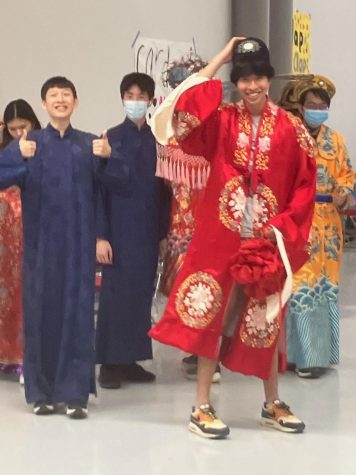
Like Ho, Tsai and Wu, who’ve celebrated the holiday back in China, want to spread the culture that they’ve known since birth.
“Lunar New Year was really a serious thing for me because all of my family is from China and I grew up there,” Wu said. “It’s when the family can unite together and eat dinner and talk about their wishes for the coming year and reflect on what they did last year. I think that it definitely shares our culture to others like what the Chinese Honor Society did a couple of weeks ago, and it lets people know that we have this and what its meaning is.”
Based on what she has seen from celebrations in the states, Tsai said the cultural acceptance and spread of Lunar New Year has only grown.
“I’ve heard that in New York and California and other cities now have lion and dragon dances, and most people are surprised to find that foreign people have joined the team,” Tsai said. “There are actually a lot of foreigners who really like the martial arts. So during the Chinese New Year, I’ve seen a lot of foreign people play drums or they are the lion head or the dragon head. So you can see that people accept the difference and they enjoy the difference found in Lunar New Year. They just love it.”
In Vu’s eyes, behind Tet’s small traditions like red envelopes, as well as its larger role as a Lunar New Year celebration, lies the significance the holiday places on family.
“It’s a lot more about embracing family and getting together, quality time,” Vu said. “Like as a child, what I looked forward to is receiving the lucky money in the red envelope. I think lucky money typically is considered a way to promote things like ‘Hey, have a good year or be conscientious of your money. But for us, it’s just a bonding experience.”
But, it’s not just family that carries weight on this holiday; Ho said the rich history behind it and its traditions are just as important.
“Lunar New Year has significance because of the fact that it dates back so far ago when the only way to tell the time is through the moon,” Ho said. “And, Lunar New Year is actually the start of the spring, so in the spring, everything starts anew. You’re able to start farming. You’re able to celebrate with people. It’s one of those happy moments where everything starts flourishing, so that’s why Chinese New Year was started then, on the new moon of this time of spring, the new moon of the new month. A new growth or a new start.”
Your donation will support the student journalists of Bellaire High School. Your contribution will allow us to purchase equipment and cover our annual website hosting costs.


